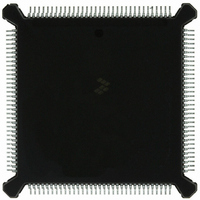MC68332GCEH16 Freescale Semiconductor, MC68332GCEH16 Datasheet - Page 106

MC68332GCEH16
Manufacturer Part Number
MC68332GCEH16
Description
IC MCU 32BIT 16MHZ 132-PQFP
Manufacturer
Freescale Semiconductor
Series
M683xxr
Specifications of MC68332GCEH16
Core Processor
CPU32
Core Size
32-Bit
Speed
16MHz
Connectivity
EBI/EMI, SCI, SPI, UART/USART
Peripherals
POR, PWM, WDT
Number Of I /o
15
Program Memory Type
ROMless
Ram Size
2K x 8
Voltage - Supply (vcc/vdd)
4.5 V ~ 5.5 V
Oscillator Type
Internal
Operating Temperature
-40°C ~ 85°C
Package / Case
132-QFP
Cpu Family
68K/M683xx
Device Core
ColdFire
Device Core Size
32b
Frequency (max)
16MHz
Interface Type
QSPI/SCI/UART
Program Memory Size
Not Required
Total Internal Ram Size
2KB
# I/os (max)
15
Number Of Timers - General Purpose
16
Operating Supply Voltage (typ)
5V
Operating Supply Voltage (max)
5.5V
Operating Supply Voltage (min)
4.5V
Instruction Set Architecture
RISC
Operating Temp Range
-40C to 85C
Operating Temperature Classification
Industrial
Mounting
Surface Mount
Pin Count
132
Package Type
PQFP
Controller Family/series
68K
No. Of I/o's
15
Ram Memory Size
2KB
Cpu Speed
16MHz
No. Of Timers
16
Embedded Interface Type
QSPI, SCI, UART
Digital Ic Case Style
PQFP
Rohs Compliant
Yes
Processor Series
M683xx
Core
CPU32
Data Bus Width
32 bit
Data Ram Size
2 KB
Maximum Clock Frequency
16 MHz
Number Of Programmable I/os
15
Number Of Timers
16
Maximum Operating Temperature
+ 85 C
Mounting Style
SMD/SMT
Minimum Operating Temperature
- 40 C
Lead Free Status / RoHS Status
Lead free / RoHS Compliant
Eeprom Size
-
Program Memory Size
-
Data Converters
-
Lead Free Status / Rohs Status
Compliant
Available stocks
Company
Part Number
Manufacturer
Quantity
Price
Company:
Part Number:
MC68332GCEH16
Manufacturer:
Freescale Semiconductor
Quantity:
10 000
- Current page: 106 of 265
- Download datasheet (7Mb)
5.4 Virtual Memory
5.5 Addressing Modes
5.6 Processing States
5-8
The full addressing range of the CPU32 on the MC68331 is 16 Mbytes in each of eight
address spaces. Even though most systems implement a smaller physical memory,
the system can be made to appear to have a full 16 Mbytes of memory available to
each user program by using virtual memory techniques.
A system that supports virtual memory has a limited amount of high-speed physical
memory that can be accessed directly by the processor and maintains an image of a
much larger virtual memory on a secondary storage device. When the processor at-
tempts to access a location in the virtual memory map that is not resident in physical
memory, a page fault occurs. The access to that location is temporarily suspended
while the necessary data is fetched from secondary storage and placed in physical
memory. The suspended access is then restarted or continued.
The CPU32 uses instruction restart, which requires that only a small portion of the in-
ternal machine state be saved. After correcting the fault, the machine state is restored,
and the instruction is fetched and started again. This process is completely transpar-
ent to the application program.
Addressing in the CPU32 is register-oriented. Most instructions allow the results of the
specified operation to be placed either in a register or directly in memory. There is no
need for extra instructions to store register contents in memory.
There are seven basic addressing modes:
The register indirect addressing modes include postincrement, predecrement, and off-
set capability. The program counter indirect mode also has index and offset capabili-
ties. In addition to these addressing modes, many instructions implicitly specify the
use of the status register, stack pointer, and/or program counter.
The processor is always in one of four processing states: normal, exception, halted, or
background. The normal processing state is associated with instruction execution; the
bus is used to fetch instructions and operands and to store results.
The exception processing state is associated with interrupts, trap instructions, tracing,
and other exception conditions. The exception may be internally generated explicitly
by an instruction or by an unusual condition arising during the execution of an instruc-
tion. Exception processing can be forced externally by an interrupt, a bus error, or a
• Register Direct
• Register Indirect
• Register Indirect with Index
• Program Counter Indirect with Displacement
• Program Counter Indirect with Index
• Absolute
• Immediate
Freescale Semiconductor, Inc.
For More Information On This Product,
CENTRAL PROCESSING UNIT
Go to: www.freescale.com
USER’S MANUAL
MC68332
Related parts for MC68332GCEH16
Image
Part Number
Description
Manufacturer
Datasheet
Request
R
Part Number:
Description:
Manufacturer:
Freescale Semiconductor, Inc
Datasheet:
Part Number:
Description:
Manufacturer:
Freescale Semiconductor, Inc
Datasheet:
Part Number:
Description:
Manufacturer:
Freescale Semiconductor, Inc
Datasheet:
Part Number:
Description:
Manufacturer:
Freescale Semiconductor, Inc
Datasheet:
Part Number:
Description:
Manufacturer:
Freescale Semiconductor, Inc
Datasheet:
Part Number:
Description:
Manufacturer:
Freescale Semiconductor, Inc
Datasheet:
Part Number:
Description:
Manufacturer:
Freescale Semiconductor, Inc
Datasheet:
Part Number:
Description:
Manufacturer:
Freescale Semiconductor, Inc
Datasheet:
Part Number:
Description:
Manufacturer:
Freescale Semiconductor, Inc
Datasheet:
Part Number:
Description:
Manufacturer:
Freescale Semiconductor, Inc
Datasheet:
Part Number:
Description:
Manufacturer:
Freescale Semiconductor, Inc
Datasheet:
Part Number:
Description:
Manufacturer:
Freescale Semiconductor, Inc
Datasheet:
Part Number:
Description:
Manufacturer:
Freescale Semiconductor, Inc
Datasheet:
Part Number:
Description:
Manufacturer:
Freescale Semiconductor, Inc
Datasheet:
Part Number:
Description:
Manufacturer:
Freescale Semiconductor, Inc
Datasheet:











